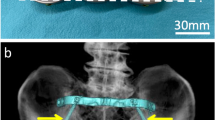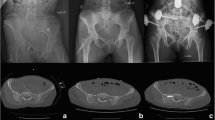Abstract
Objectives
To characterize pelvic-specific functional outcomes in patients with isolated, partially unstable (AO/OTA 61-B), pelvic ring injuries treated with posterior only percutaneous screw fixation of the pelvic ring.
Patients and methods
Between September 2007 and October 2011, 16 subjects (mean age 42.4 years; range 18–90 years) with isolated, partially unstable pelvic ring injuries (AO/OTA 61-B) were treated with percutaneous, posterior pelvic ring fixation. Subjects underwent an evaluation of pelvic ring function with a modification of Majeed’s pelvic functional outcome assessment tool. Subjects were excluded if they sustained a concomitant long-bone fracture, visceral injury requiring surgery, spinal cord injury, and an injury to the anterior pelvic ring or acetabulum requiring additional fixation.
Result
Mean follow-up was 30.8 (range 14–55) months. Eleven subjects sustained unilateral posterior ring injuries, and five subjects sustained bilateral posterior ring injuries. All fractures healed uneventfully, and no hardware failures were noted. Average pelvic functional outcome score at final follow-up was 85.3 % (good). All but subjects required assistive walking devices and gait and sitting comfort scored “excellent.” High rates of sexual dysfunction and persistent difficulty with daily activities were noted in this series.
Conclusions
This series demonstrates that activity-specific dysfunction persists years after definitive percutaneous posterior fixation of isolated pelvic ring injuries. Radiographic outcomes were excellent as were subjects’ ability to ambulate independently and sit comfortably without pain. Many complained of persistent discomfort with both daily activities and sexual activity, suggesting persistent pathology to the non-osseous structures about the pelvis.
Similar content being viewed by others
References
Routt ML, Kregor PJ, Simonian PT et al (1995) Early results of percutaneous iliosacral screws placed with the patient in the supine position. J Orthop Trauma 9(3):207–214
Shuler TE, Boone DC, Gruen GS et al (1995) Percutaneous iliosacral screw fixation: early treatment for unstable posterior pelvic ring disruptions. J Trauma 38(3):453–458
Routt ML, Simonian PT, Mills WJ (1997) Iliosacral screw fixation: early complications of the percutaneous technique. J Orthop Trauma 11(8):584–589
Routt ML, Nork SE, Mills WJ (2000) Percutaneous fixation of pelvic ring disruptions. Clin Orthop Relat Res 375:15–29
Lindahl J, Hirvensalo E (2005) Outcome of operatively treated type-C injuries of the pelvic ring. Acta Orthop 76(5):667–678
Nork SE, Jones CB, Harding SP et al (2001) Percutaneous stabilization of U-shaped sacral fractures using iliosacral screws: technique and early results. J Orthop Trauma 15(4):238–246
Routt ML, Simonian PT (1996) Closed reduction and percutaneous skeletal fixation of sacral fractures. Clin Orthop Relat Res 329:121–128
Griffin DR, Starr AJ, Reinert CM et al (2006) Vertically unstable pelvic fractures fixed with percutaneous iliosacral screws: does posterior injury pattern predict fixation failure? J Orthop Trauma 20(1 Suppl):S30–S36 discussion S36
Cole JD, Blum DA, Ansel LJ (1996) Outcome after fixation of unstable posterior pelvic ring injuries. Clin Orthop Relat Res 329:160–179
Schweitzer D, Zylberberg A, Córdova M et al (2008) Closed reduction and iliosacral percutaneous fixation of unstable pelvic ring fractures. Injury 39(8):869–874
Majeed SA (1989) Grading the outcome of pelvic fractures. J Bone Joint Surg Br 71(2):304–306
Suzuki T, Hak DJ, Ziran BH et al (2009) Outcome and complications of posterior transiliac plating for vertically unstable sacral fractures. Injury 40(4):405–409
Dujardin FH, Hossenbaccus M, Duparc F et al (1998) Long-term functional prognosis of posterior injuries in high-energy pelvic disruption. J Orthop Trauma 12(3):592–593
Lindahl J, Hirvensalo E, Böstman O, Santavirta S (1999) Failure of reduction with an external fixator in the management of injuries of the pelvic ring. Long-term evaluation of 110 patients. J Bone Joint Surg Br 81(6):955–962
Van den Bosch EW, Van der Kleyn R, Hogervorst M et al (1999) Functional outcome of internal fixation for pelvic ring fractures. J Trauma 47(2):365–371
Suzuki T, Shindo M, Soma K et al (2007) Long-term functional outcome after unstable pelvic ring fracture. J Trauma 63(4):884–888
Mullis BH, Sagi HC (2008) Minimum 1-year follow-up for patients with vertical shear sacroiliac joint dislocations treated with iliosacral screws: does joint ankylosis or anatomic reduction contribute to functional outcome? J Orthop Trauma 22(5):293–298
Marsh J, Slongo T, Agel J et al (2007) Fracture and dislocation classification compendium—2007: Orthopaedic Trauma Association classification, database, and outcomes committee. J Orthop Trauma 21(10):S1–S133
Tornetta P, Matta JM (1996) Outcome of operatively treated unstable posterior pelvic ring disruptions. Clin Orthop Relat Res 329(329):186–193
Oliver CW, Twaddle B, Agel J et al (1996) Outcome after pelvic ring fractures: evaluation using the medical outcomes short form SF-36. Injury 27(9):635–641
Vallier HA, Cureton BA, Schubeck D (2012) Pelvic ring injury is associated with sexual dysfunction in women. J Orthop Trauma 26(5):308–313
Copeland CE, Bosse MJ, McCarthy ML, MacKenzie EJ et al (1997) Effect of trauma and pelvic fracture on female genitourinary, sexual, and reproductive function. J Orthop Trauma 11(2):73–81
Kiely N, Williams N (1996) Sexual dysfunction in women following pelvic fractures with sacro-iliac disruption. Injury 27(1):45–46
Conflict of interest
None.
Author information
Authors and Affiliations
Corresponding author
Rights and permissions
About this article
Cite this article
Sullivan, M.P., Scolaro, J.A., Milby, A.H. et al. Isolated pelvic ring injuries: functional outcomes following percutaneous, posterior fixation. Eur J Orthop Surg Traumatol 25, 1025–1030 (2015). https://doi.org/10.1007/s00590-015-1631-4
Received:
Accepted:
Published:
Issue Date:
DOI: https://doi.org/10.1007/s00590-015-1631-4




